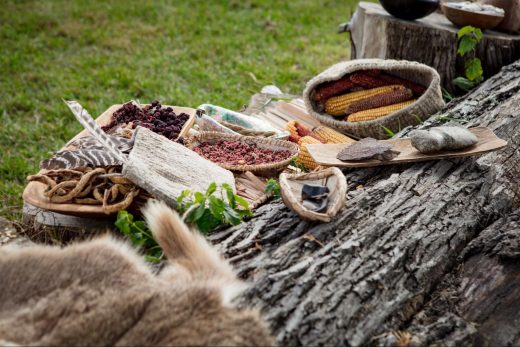
Acknowledging Native American communities is usually relegated to discussions of the past, or during the colonialist holiday Thanksgiving. But Indigenous communities throughout North America have retained their unique cultures and histories, and food is a large part of that.
This week’s edition of Weekly Bites explores ways that Indigenous chefs are reclaiming their culinary traditions.
Many ingredients we use today — such as corn, tomato, and squash — are indigenous to the United States. Native American communities introduced us to these ingredients, as well as methods of preparation. When the federal government drove Native Americans from their ancestral lands in the 1800s, they were forced onto land that was undesirable and not easily cultivated. As a result, Indigenous peoples lost many of their foodways — the culinary practices that shaped their culture, history, and traditions. As resources became scarce, Native ways of growing, eating, and preparing food no longer played a major role in the diet of Native Americans.
Native American groups are now looking to revive their own foodways in new and creative ways. This edition of Weekly Bites summarizes three stories that give hope for a flourishing Native American cuisine.
Connecting through food to combat addiction
Café Gozhóó, in the White Mountain Apache reservation in Arizona, is celebrating Western Apache food while targeting two problems rampant in Native American communities — the lack of access to fresh and nutritious food, and addiction.
A 2018 survey found that 1 in 5 Native American young adults had a substance use disorder. This is often due to a mix of historical trauma, and alcohol being readily available on reservations.
Another health concern in reservations is diabetes and hypertension. Native American reservations often lack access to fresh and nutritious food. This Guardian article about Café Gozhóó sheds light on why this is the reality:
“Food deserts are common on reservations because when colonizers forced Native Americans off their ancestral lands, they also restricted their access to the plants they had long grown and even required them to raise different types of livestock. And reservations were often on land that wasn’t conducive to agriculture, so communities came to rely on government food rations, which were often culturally inappropriate and less nutritious than their traditional foods.”
If you’ve ever had fry bread, a white bread fried in lard, then you’ve tasted the (albeit tasty) outcome of unequal access to healthy foods. Although fry bread has become a cultural food for many Native American communities, it sprang from poverty and limited access to pantry staples beyond white flour and lard.
Executive Chef Nephi Craig, who is White Mountain Apache and Diné (Navajo), founded Café Gozhóó as a culturally relevant complement to traditional addiction treatment. The cafe’s kitchen teaches therapeutic skills like stress management and teamwork, while connecting people to their ancestral foods.
All of the produce for the cafe is grown locally at Ndée Bikíyaa, People’s Farm, a project of the White Mountain Apache water resources department. This farm acts as a nutritional oasis that provides the community with food that they wouldn’t otherwise have easy access to.
Although kitchens can be a source of stress and substance abuse, the kitchen at Café Gozhóó is about camaraderie, collaboration, and healing years of generational trauma.
The emergence of Native American cuisine
Native American is not a monolith of a culture, and different Native American groups have distinct cultural practices and languages. So, is it really possible to speak of a single Native American cuisine?
While each group has different cultural practices, there are some foods that many Native American groups have in common. One example is Three Sisters, which refers to the agricultural practice of planting squash, beans, and corn in a symbiotic relationship. Many Native American groups, both in the Northeast and the Southwest, feature the Three Sisters in their cuisine.
Saveur recently did a spotlight on four Native American chefs who are bringing Native American food culture to the table. Not only is this important for preserving Native cultures, but highlighting Native American ingredients and foodways is important for the environment. Indigenous plants are naturally more resistant to weather and pests than imported plants. The article also notes that, “promoting food sovereignty can empower the people—from the growers and harvesters to the cooks and chefs—who are sustaining these ingredients.”
Add Native to your cart
Native American entrepreneurs across the country are developing food businesses in order to support their communities. Tocabe Indigenous Market is on a mission to bring them all together.
Tocabe is an online marketplace where you can source Native ingredients like heirloom beans, grass-fed bison, and rice. All items are produced by Native entrepreneurs, and for every two items sold, Tocabe donates one item directly back to Native American communities. This helps combat food scarcity on reservations and supports communities directly.
Ben Jacobs (Osage Nation), co-founder of Tocabe says, “We’re not just buying a bunch of ingredients; we’re building a relationship with the growers and producers and making sure we’re supporting the Indigenous economy.”
~~~~
Chef Works blends fashion and functionality to provide chefs and other industry workers with apparel that looks good and gets the job done. Have you explored our online catalog today for the latest styles?


